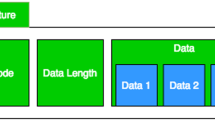Abstract
Internet of things (IoT) points out an inspiring road towards intelligent world of real-time information collection and interaction among people and entities. It may provide various applications by connecting all the existing communication networks. To ensure the reliability of end-to-end transmission in the hierarchical environments, fault management is of great importance. Current relative algorithms are designed for specific network, not suited to these complex conditions. Meanwhile, the utilization of existing facilities should be considered for implementation feasibility. In this paper, we propose a layered fault management scheme for IoT with uniform fault managing procedure control and separate layer functions. Flexible and effective monitoring model would be set in selected observing points around the networks. Advanced fuzzy cognitive maps (FCM) is adopted to realize integrated evaluation and prediction of the possible fault. The observing points could adjust the weighting rule in the model to suit the practical network condition and work independently. After further confirmation among neighbor points, fault recovery therapy could be handed over to the corresponding network with existing counter-measures. The proposed design suits well to the efficiency and feasibility requirements of IoT. Simulation results further prove its desirable behavior.













Similar content being viewed by others
References
Kopetz H (2011) Internet of things. Real-Time Systems Series, 307–323
Gershenfeld N, Krikorian R, Cohen D (2004) The internet of things. Scientific American 291(44):76–81
Chen S, Shi Y, Bo H (2007) Survey on the mobility management theory and technology. Journal on Communications 28(10):123–133
Chen M, Gonzalez S, Vasilakos A, Cao H, Leung V (2011) Body area networks: a survey. ACM/Springer Mobile Networks and Applications 16(2):171–193
Chen M, Gonzalez S, Leung V, Zhang Q, Li M (2010) A 2G-RFID based E-healthcare system. IEEE Wireless Communications Magazine 17(1):37–43
Chen M, Gonzalez S, Zhang Q, Leung V (2010) Code-Centric RFID system based on software agent intelligence. IEEE Intelligent Systems 25(2):12–19
Breitgand D, Raz D, Shavitt Y (2002) SNMP GetPrev: an efficient way to access data in large MIB tables. IEEE Journal of Selected Areas in Communication 20(4):656–667
Elhadef M, Boukerche A, Elkadiki H (2006) Diagnosing mobile ad-hoc networks: two distributed comparison-based self-diagnosis protocols. 4th ACM International Workshop on Mobility Management and Wireless Access, pp 18–27
Asim M, Mokhtar H, Merabti M (2008) A fault management architecture for wireless sensor network. Proceedings of Wireless Communications and Mobile Computing Conference 2008:779–785
Chessa S, Santi P (2001) Comparison-based system-level fault diagnosis in ad hoc networks. Proceedings of Relable Distributed Systems, 20th IEEE symposium, pp 257–266
Yu M, Mokhtar H, Merabti M (2007) Fault management in wireless sensor networks. Wireless Communications, IEEE 14(6):13–19
Varga P, Moldovan I (2007) Integration of service-level monitoring with fault management for end-to-end multi-provider ethernet services. Network and Service Management, IEEE Transactions on 4(1):28–38
Habib T, Inglada J, Mercie G (2009) Support vector reduction in SVM algorithm for abrupt change detection in remote sensing. Geoscience and Remote Sensing Letters, IEEE 6(3):606–610
Duan X, Liu Z, Liu H (2010) Network intrusion detection by rough set and least squares support vector machine. Signal Processing Systems (ICSPS), 2010 2nd International Conference 1:564–566
Steinder M, Sethi AS (2004) Probabilistic fault localization in communication systems using belief networks. Networking, IEEE/ ACM Transactions on 12(5):809–822
Sethi AS (2004) A survey of fault localization techniques in computer networks. Science of Computer Programming 53(2):165–194
Samanta B, Al-Balushi KR, Al-Araimi SA (2004) Bearing fault detection using artificial neural networks and genetic algorithm. EURASIP Journal on Applied Signal Processing 1:366–377
Kosko B (1986) Fuzzy cognitive maps. International Journal of Man–machine Studies 24:65–75
Acknowledgement
This paper is sponsored by the Youth Innovation Research Plan of BUPT under Grand 2011RC0110, the National Youth Nature Science Foundation under Grand 61001115 and the Beijing Nature Science Foundation under Grand 4102044.
Author information
Authors and Affiliations
Corresponding author
Rights and permissions
About this article
Cite this article
Li, X., Ji, H. & Li, Y. Layered Fault Management Scheme for End-to-end Transmission in Internet of Things. Mobile Netw Appl 18, 195–205 (2013). https://doi.org/10.1007/s11036-012-0355-5
Published:
Issue Date:
DOI: https://doi.org/10.1007/s11036-012-0355-5




